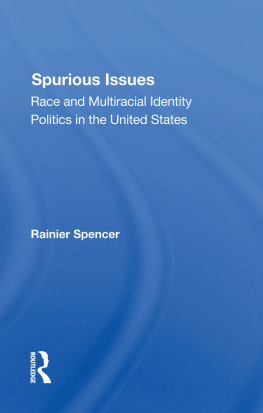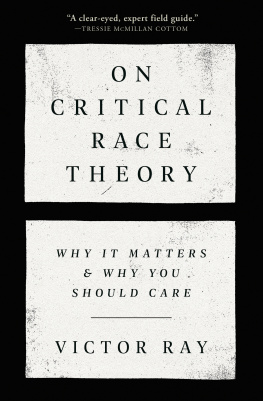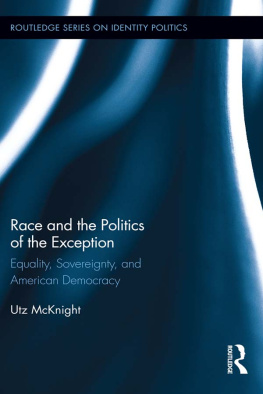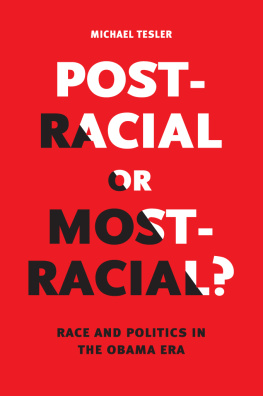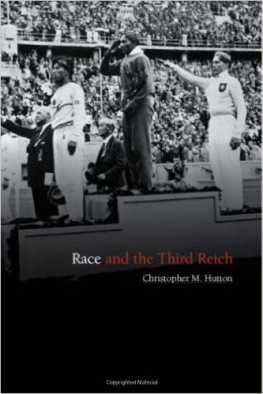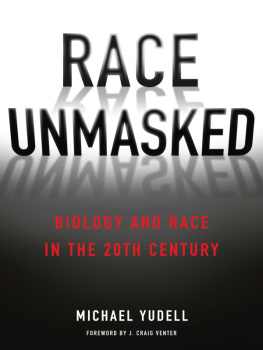Thank you for buying this ebook, published by NYU Press.
Sign up for our e-newsletters to receive information about forthcoming books, special discounts, and more!
Sign Up!
About NYU Press
A publisher of original scholarship since its founding in 1916, New York University Press Produces more than 100 new books each year, with a backlist of 3,000 titles in print. Working across the humanities and social sciences, NYU Press has award-winning lists in sociology, law, cultural and American studies, religion, American history, anthropology, politics, criminology, media and communication, literary studies, and psychology.
The Rise and Fall of the Caucasian Race
The Rise and Fall of the Caucasian Race
A Political History of Racial Identity
Bruce Baum

NEW YORK UNIVERSITY PRESS
New York and London
www.nyupress.org
2006 by New York University
All rights reserved
Library of Congress Cataloging-in-Publication Data
Baum, Bruce David, 1960
The rise and fall of the Caucasian race :
a political history of racial identity / Bruce Baum.
p. cm.
Includes bibliographical references and index.
ISBN13: 9780814798928 (cloth : alk. paper)
ISBN10: 0814798926 (cloth : alk. paper)
1. Caucasian raceHistory. 2. Race awarenessPolitical aspects.
3. WhitesRace identity. I. Title.
HT1575.B385 2006
305.809073dc22 2005024718
New York University Press books are printed on acid-free paper,
and their binding materials are chosen for strength and durability.
Manufactured in the United States of America
c 10 9 8 7 6 5 4 3 2 1
p 10 9 8 7 6 5 4 3 2 1
For Laura
Contents
Preface
One of the better answers I have heard regarding the question of race came from my uncle, David Widrow. Several years ago, as I began thinking about this study, I asked him if he thought there were different human races. He smiled and said, Sure. There are running races, auto races, boat races. I thought it was a great answer, but at other times my uncle, like most people in the United States, has accepted the current common sense view that there are also distinct human races in the biological sense.
Part of my argument is that this commonsense view is a historical artifact of the social and political history of the modern world. All ideas about race, like many other beliefs and theories, need to be understood in relation to their historical contexts, including the view of race that I advance here. (Yet, as I will explain, this does not mean that all accounts of race are equally valid or invalid.) In the present case, my examination of the Caucasian race idea has been motivated by my time and place, as a U.S. citizen, born during the Civil Rights movement. (One of my early memories is of an assembly at my Stamford, Connecticut elementary school in 1968, right after the assassination of Martin Luther King Jr.)
This book joins many related efforts in the postCivil Rights movement era to understand how much and in what way wecitizens of the United States and members of a would-be global communityneed to take account of race to move beyond to nefarious legacy of racism. It is largely a history of the Caucasian-race idea written by a scholar of politics. It is also a political theorists inquiry into the meaning of race, and therefore a few sections are theoretically dense.
I wish to thank several people who helped me complete this book. Sandy Schram read most of the manuscript, provided ongoing encouragement, and pointed me to New York University Press. David Roediger offered important feedback when I began the project. Charles Mills and Joel . Several former colleagues at Macalester College provided constructive early comments: Duchess Harris, Sal Salerno, Karin AguilarSan Juan, Andrew Latham, Kiarini Kordela, Michele Edwards, Ruthann Godollei, Leola Johnson, Michal McCall, David Moore, Clay Steinman, Jolle Vitiello, and Matthew Weinstein. Im especially thankful to Duchess, Sal, Karin, Andrew, and Kiarini for their encouragement. Patrick Guarasci, a former student, provided early research help. At NYU Press, Stephen Magro, who began this project, and Ilene Kalish, who saw it to completion, were great to work with, and I have also benefited from comments by the reviewers for the press. Taiwo Adetunji Osinubi and Anna Karlen translated some key German texts, and the UBC Political Science Department provided financial support for these translations. Kristin Cavoukian did great work on the index. I owe Sele Nadel-Hayes special thanks for sharing her family history with me. Two friends, David Rafferty and Paul Soper, patiently listened to lots of Caucasian talk over the last several years, and my parents, Charles and Rosalyn, and extended family have been continually supportive. Special thanks to my sister, Andrea Stuart, for designing great art for the books cover, which (sadly) was not used.
Finally, I owe the biggest thanks to Laura Janara. Laura read and commented insightfully on the introduction and . More than that, she has been a wonderful, loving partner in the life of the mind and in the joys and trials of daily living.
Introduction
Caucasians and the Political History of Racial Identities
[T]he Light of human minds is Perspicuous Words, but by exact definitions first snuffed, and purged from ambiguity; Reason is the pace; Encrease of Science, the way; and the Benefit of man-kind, the end. And on the contrary, Metaphors, and senselesse and ambiguous words, are like ignes fatui; and reasoning upon them, is wandering amongst innumerable absurdities.
Thomas Hobbes, Leviathan (1651)
The classificatory thinking of each individual is one of the ways by which [human beings] try to adapt to reality in a way that best meets their needs. But... [t]he world which is given to the individual and which he [sic] must accept and take into account is, in its present and continuing form, a product of the activity of society as a whole.... The facts which our senses present to us are socially performed in two ways: through the historical character of the object perceived and through the historical character of the perceiving organ. Both are not simply natural; they are shaped by human activity.
Max Horkheimer, Traditional and Critical Theory (1937)
How shall we think about the status of our social identities? By social identity I mean the identities we have as blacks, Caucasians, women, Latinos, gays, and so on.
Georgia Warnke, Social Identity as Interpretation (2002)
One of the many telling artifacts of the modern world is the fact that there are Caucasians and then there are Caucasians. That is, there are the various Caucasian peoples of the Caucasus Mountain regionfor example, Georgians, Dagestanis, Circassians, Chechens, Ossetians, and othersand there are the presumed members of the Caucasian race. The latter is a curious invention of the modern age; it has been a basic component of numerous influential racial classifications from the late eighteenth century through the dawn of the twenty-first.
This book is primarily concerned with the peculiar career of the idea of a Caucasian race. Yet the histories of the two concepts of Caucasianspeoples of the Caucasus and the Caucasian raceare intertwined. Consider the following:
Caucasian Slaves in the Middle Ages
Between the thirteenth and fifteenth centuries CE, before there was any notion of a Caucasian race, Caucasian peoples were bought and sold as slaves by Venetian and Genoese merchants. This was part of a long history of enslavement of Christians by Muslims and of Muslims by Christians in the Middle Ages that prepared the way for the vast Atlantic slave system in which Europeans subjugated sub-Saharan Africans.
Next page

